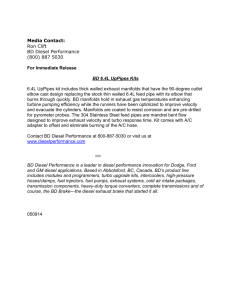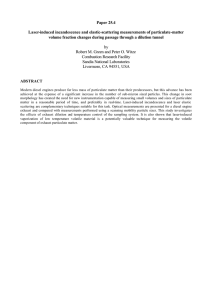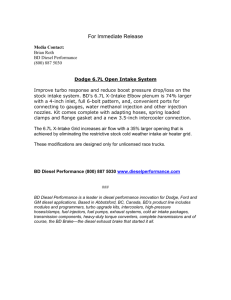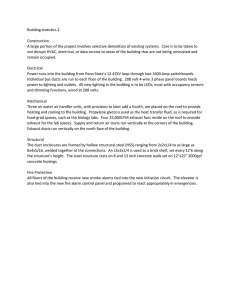Safe Working with Diesel Engine Exhaust
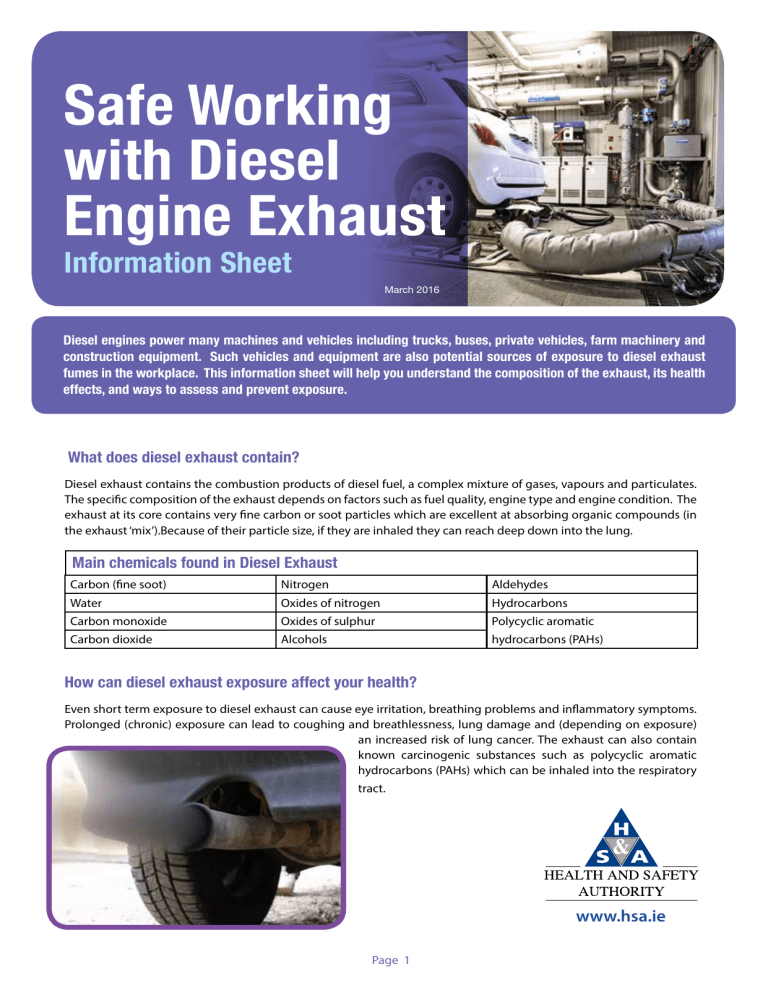
Jan 2016
Safe Working with Diesel
Engine Exhaust
Information Sheet
March 2016
Diesel engines power many machines and vehicles including trucks, buses, private vehicles, farm machinery and construction equipment. Such vehicles and equipment are also potential sources of exposure to diesel exhaust fumes in the workplace. This information sheet will help you understand the composition of the exhaust, its health effects, and ways to assess and prevent exposure.
What does diesel exhaust contain?
Diesel exhaust contains the combustion products of diesel fuel, a complex mixture of gases, vapours and particulates.
The specific composition of the exhaust depends on factors such as fuel quality, engine type and engine condition. The exhaust at its core contains very fine carbon or soot particles which are excellent at absorbing organic compounds (in the exhaust ‘mix’).Because of their particle size, if they are inhaled they can reach deep down into the lung.
Main chemicals found in Diesel Exhaust
Carbon (fine soot)
Water
Carbon monoxide
Nitrogen
Oxides of nitrogen
Oxides of sulphur
Carbon dioxide Alcohols
Aldehydes
Hydrocarbons
Polycyclic aromatic hydrocarbons (PAHs)
How can diesel exhaust exposure affect your health?
Even short term exposure to diesel exhaust can cause eye irritation, breathing problems and inflammatory symptoms.
Prolonged (chronic) exposure can lead to coughing and breathlessness, lung damage and (depending on exposure) an increased risk of lung cancer. The exhaust can also contain known carcinogenic substances such as polycyclic aromatic hydrocarbons (PAHs) which can be inhaled into the respiratory tract.
Page 1
www.hsa.ie
Cyan 100%
Magenta 76%
Yellow 0
Black 27%
SAFE WORKING WITH DIESEL ENGINE EXHAUST
Information sheet
How to risk assess diesel exhaust exposure
Where there are diesel engines of one kind or another in the workplace, there is a risk of exposure to diesel exhaust. The exposure risk should be assessed as part of your overall chemical risk assessment. The risk assessment will help you to make the correct decisions, and should be based on the following questions:
• Is there a potential hazard of exposure to diesel exhaust in my workplace?
• Is the risk of exposure high or low?
• Who is being exposed and to what extent?
• How many employees are being exposed and for how long?
• How can exposure be prevented or minimised?
• If action is necessary to prevent potential exposure, have you prioritised your actions?
Assessment of exposure
The following pointers should help you identify the probable level of exposure:
LOW PROBABILITY
There is no visible haze or smoke in the workplace. The workplace is well ventilated
No visible soot deposits
MEDIUM PROBABILITY
There is smoke occasionally
Soot deposits in certain areas
HIGH PROBABILITY
There is smoke in the workplace permanently
No related complaints from employees
Some complaints from employees of related health irritants
Heavy soot deposits especially near emission points
High degree of complaint from exposed workers
Because of the complex and variable composition of diesel exhaust, occupational hygiene monitoring can be difficult. The Health and Safety
Authority intend withdrawing the occupational exposure limit value
(OELV) for diesel exhaust (as indicated in schedule 2 of the 2016 Code of Practice for the Safety Health and Welfare at Work (Chemical
Agents) Regulations 2001). The
OELV is being withdrawn because of uncertainties regarding the scientific data supporting the value and also because there is no valid test method for the OELV as stated.
Page 2
SAFE WORKING WITH DIESEL ENGINE EXHAUST
Information sheet
Some authorities recommend measuring carbon dioxide levels as an alternative method of establishing exposure potential. Fresh air contains some level of carbon dioxide, but levels above 1000 ppm would be a concern:
Carbon dioxide level (CO2) >1000 ppm, 8 hr. TWA*
1000 ppm, 8 hr. TWA
<1000 ppm, 8 hr. TWA
Controls are inadequate
Controls need improving
Controls likely to be adequate
*For further advice on occupational exposure limit terms, see the latest Code of Practice available at www.hsa.ie
under publications
How to prevent exposure
The best way to control a hazard is to eliminate it. Can the exhaust be removed from the workplace? There are scenarios where natural gas or electricity can substitute as the energy or fuel source.
If the exhaust cannot be removed from the workplace, a number of options can be used to prevent exposure:
• Change the work methods
• Modify the layout
• Change the work procedures
Engineering controls
Is the workplace well ventilated naturally or mechanically so there is a good flow of fresh air? As well as general ventilation within the workplace, consider local exhaust ventilation (LEV) as it can efficiently remove diesel exhaust fumes at the point of release into the workplace (rather than relying on dilution of the fumes by general ventilation). Local exhaust ventilation can capture vehicle exhaust in workplaces such as garages or vehicle test centres. See our Local Exhaust Ventilation (LEV) Guidance , available at www.hsa.ie
under publications.
You should also consider whether the workshop can be separated from the garage with its own ventilation systems, or whether vehicles can be kept outside. Well maintained, fuel-efficient engines and fuel quality also play a part in preventing the generation of exhaust.
Administrative controls
Administrative controls can support engineering controls to maximise exposure prevention. For example, in a bus or car garage work can be organised to prevent running engines unnecessarily
(idling). The number of employees in the work area should be minimised – administrative staff, for example, should remain in separate areas or offices.
Page 3
SAFE WORKING WITH DIESEL ENGINE EXHAUST
Information sheet
Respiratory Protective Equipment
Exposure is best controlled at the source. Respiratory Protective Equipment (RPE) should only be used as a last resort.
RPE must be suitable and properly fitted. The RPE chosen should be suitable for protecting against hazardous gases and particles. Where negative (air filtering) respirators are worn, fit-testing must be carried out. See A Guide to Respiratory
Protective Equipment , available at www.hsa.ie
under publications.
Health surveillance
Health surveillance is appropriate when the exposure of an employee to a hazardous chemical agent is such that a clinically identifiable illness or adverse health effect may be related to the exposure. It may also be needed if there is a reasonable likelihood that the illness or effect may occur or there are valid low-risk techniques available for detecting indications of the illness or effect. See Guidelines to the Safety, Health and Welfare at Work (Chemical Agents) Regulations,
2001 , available at www.hsa.ie
under publications.
Training and information for employees
Information, training and instruction should be given to employees on the health hazards relating to diesel exhaust.
Employees or their safety representative should be involved with the risk assessment and informed of its outcomes.
They should be trained in the proper use of control measures. The information, training and instruction should help employees to recognise the risks and associated hazards and enable them collaborate with management in protecting their health and safety.
Relevant legislation
Safety, Health and Welfare at Work Act 2005
Safety, Health and Welfare at Work (Chemical Agents) Regulations 2001 and 2015
Safety, Health and Welfare at Work (Carcinogens) Regulations 2001 and 2015
Safety, Health and Welfare at Work (General Applications) Regulations as amended.
(Not an exhaustive list)
Further Information
Visit www.hsa.ie
for more information on chemical safety in the workplace.
Page 4 www.hsa.ie
Cyan 100%
Magenta 76%
Yellow 0
Black 27%
